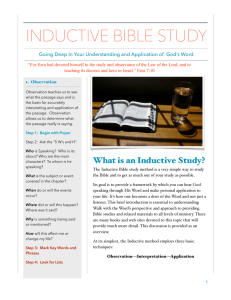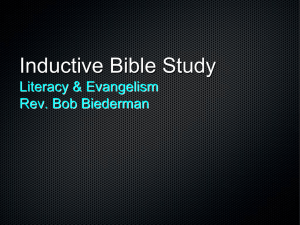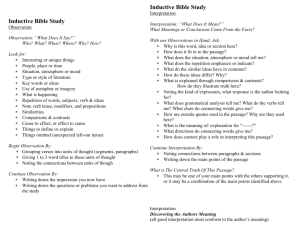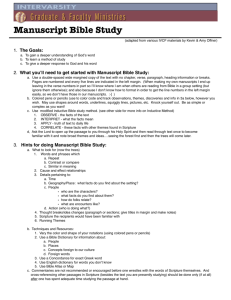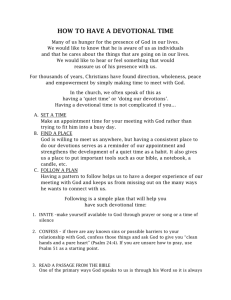Inductive Bible Study
advertisement
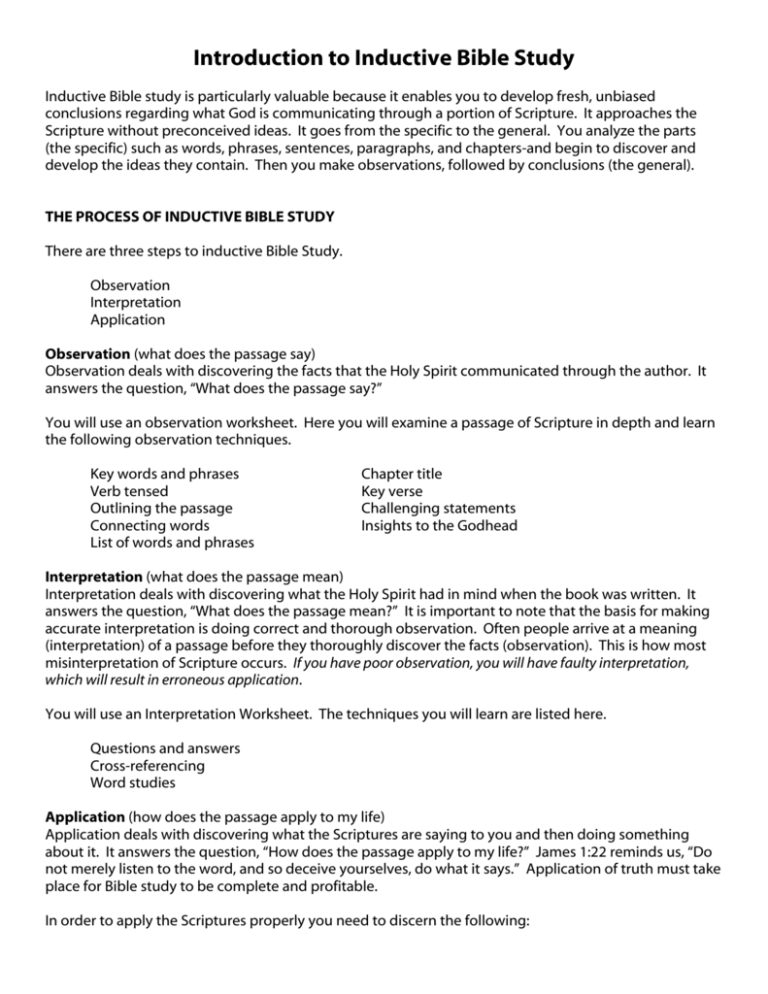
Introduction to Inductive Bible Study Inductive Bible study is particularly valuable because it enables you to develop fresh, unbiased conclusions regarding what God is communicating through a portion of Scripture. It approaches the Scripture without preconceived ideas. It goes from the specific to the general. You analyze the parts (the specific) such as words, phrases, sentences, paragraphs, and chapters-and begin to discover and develop the ideas they contain. Then you make observations, followed by conclusions (the general). THE PROCESS OF INDUCTIVE BIBLE STUDY There are three steps to inductive Bible Study. Observation Interpretation Application Observation (what does the passage say) Observation deals with discovering the facts that the Holy Spirit communicated through the author. It answers the question, “What does the passage say?” You will use an observation worksheet. Here you will examine a passage of Scripture in depth and learn the following observation techniques. Key words and phrases Verb tensed Outlining the passage Connecting words List of words and phrases Chapter title Key verse Challenging statements Insights to the Godhead Interpretation (what does the passage mean) Interpretation deals with discovering what the Holy Spirit had in mind when the book was written. It answers the question, “What does the passage mean?” It is important to note that the basis for making accurate interpretation is doing correct and thorough observation. Often people arrive at a meaning (interpretation) of a passage before they thoroughly discover the facts (observation). This is how most misinterpretation of Scripture occurs. If you have poor observation, you will have faulty interpretation, which will result in erroneous application. You will use an Interpretation Worksheet. The techniques you will learn are listed here. Questions and answers Cross-referencing Word studies Application (how does the passage apply to my life) Application deals with discovering what the Scriptures are saying to you and then doing something about it. It answers the question, “How does the passage apply to my life?” James 1:22 reminds us, “Do not merely listen to the word, and so deceive yourselves, do what it says.” Application of truth must take place for Bible study to be complete and profitable. In order to apply the Scriptures properly you need to discern the following: What is the cultural setting? Does that cultural setting apply today? What is the historical setting? Does it apply to a specific time in history or a specific historical situation? What is the context? Be sure you understand how the passage fits into the chapter and the book as a whole. Be careful not to apply Scripture out of context. To whom was the author writing and why? Was it written to a group or individual? Was the author teaching, challenging, correcting, or warning? Book Survey Before you make observations on individual portions of a particular book, you will first conduct a survey of the entire book. Much of the background information on a book can be discovered by reading through the entire book several times and recording information. However, there is a great amount of information that cannot be learned from the text itself. To discover this information, you may need to rely on other resource materials, such as study Bible, Bible handbook, or commentary. The book survey may contain such information as Author Date and place of writing To whom was the book written Historical background Purpose of writing Theme(s) Book outline Resource Material To aid you in inductive Bible study you may want to acquire the following Bible study resources: Concordance Bible dictionary Bible translations and paraphrases You may also want to acquire the following Bible study resources: Study Bible Bible handbook Commentary Note: Except for the Book Survey, do not use a commentary or Bible handbook until after you have completed your own personal study of the passage. Commentaries and handbooks are the work of men and women, probably godly men and women, even though they can be helpful, they are not necessarily inspired by God. They can also cause you to have preconceived ideas about the passage before you begin your study. So be careful to do you own study before referring to these resources. Preparation Sequence The sequence for doing the inductive Bible study is important. First complete a Book Survey. Next, complete the Observation Worksheet. Then complete the Interpretation Worksheet. Finally complete the Application Worksheet You may find that as you are preparing one worksheet, you may have some thoughts that pertain to one of the other worksheets. Briefly make a note of your thoughts on that worksheet or a separate sheet of paper, then return to your work on the original worksheet. How To Do A Book Survey Before you study any book of the Bible, it is beneficial to first do a book survey. Every book of the Bible was written in a historical context and for a definite purpose. A book survey is designed to help you get a good overview of the book before you begin a chapter-by-chapter analysis. It is important to look at the whole before you analyze the parts. The first place to look while conducting the survey is in the book itself. Study the book like a detective looking for clues. The following steps should be taken in conducting a book survey: 1. Prayerfully read the book in one setting. a. Do not take time to do any detailed analysis. When you finish this first reading write down some of your initial impressions. 2. Re-read the book several times and record the information listed below. There may not be any information on some of these areas. Record as much as you can find before relying on outside resources. a. The author. What information is revealed about the author? In what manner or tone dos he write to the recipients? b. Date and place of writing. Are there any events or locations mentioned that would give you this information c. To whom written. What does the book say about the people to whom the author is writing? Who were some of the key people mentioned? d. Historical background. Record any references to geographical location, historical events or customs of the time. e. Purpose of the book. List any stated purposes as to why the author wrote the book. f. Broad book outline. For each chapter of the book or major section of the book, write a brief statement that tells generally what the chapter or section contains. 3. Refer to additional reference material for the information you could not obtain from the text. Do this only after completing you own investigation of the book. Some suggested reference materials are: Study Bibles, Commentaries, Bible handbooks. How To Do Interpretation 1. Questions and Answers This is the first of three interpretation techniques you will learn. Questions play a valuable role in the interpretation phase by causing you to look at the various facets of meaning of a word, phrase, or passage. Questions that are very helpful are summed up in the following poem. I have six faithful men Who taught me all I knew Their names are What and Where and When And How and Why and Who. Rudyard Kipling Who-----are the people involved? is speaking, or being spoken to, or about? What----is taking place? information is being conveyed? is the atmosphere in which it is written? is the attitude of the writer? When----was it written? will these things happen? did these things happen? Where---is the writer; his recipients? will these things take place? Why-----was it written? presented in this way or sequence? so much or so little attention given to this subject? this illustration is used? How-----will it be accomplished? does it relate to other events or statements Note: It is important to ask good, penetrating questions during the interpretation phase of the Bible study. Good questions will help you to discover the meaning the Holy Spirit intended when the book was written. Ask question that cause you to discover the thinking of the author. The “why” question is good in this instance. Just as a young child uses the question “why” to cause you to think deeper into an area, so you, too, should use the “why” question to go deeper into the meaning of the passages you are studying. You may ask questions like: What are the implications/ramifications of this passage for Christians today? How does this apply to my situation? Keep in mind that the Bible was not given primarily to increase our knowledge but to change our lives. Good questions will lead to meaningful application of the Scripture. 2. Cross-Referencing A cross-reference is another passage of Scripture that supports, explains, amplifies, or gives historical insight to the Scripture that you are studying. Cross-references will provide some answers to questions that arise during your study. Using Scripture to interpret Scripture is one of the best ways to help understand the passage. There are a number of ways to do cross-referencing. Three types of cross-references to look for are historical, parallel, and explanatory. a. Historical. The epistles were written in a historical context. You can often find crossreferences to some of the situations in the book of Acts or other epistles. Sometimes you may find historical cross-references in the Gospels or the Old Testament. Example: In 1 Thessalonians 1:1, Paul addressed his letter, “To the church of the Thessalonians.” Acts 17:1-9 describes Paul’s ministry to them. b. Parallel. A parallel reference is a passage that discusses the same material you are studying but gives a different perspective or greater insight. Example: Colossians 3:18-21 discusses family relations. A good cross-reference is Ephesians 5:22-6:4, which discusses the same information in more detail. Another example would be to compare the parable of the sower in Matthew 13:3-23 to the passages in Mark 4:1-20 and Luke 8:4-15. c. Explanatory. You may find a good example or illustration in another passage of Scripture. Other passages can give greater insight into a work or a phrase or a passage you are studying. Examples: In Philippians 1:4, Paul says he prays for his readers. Colossians 1:9-12 is a good example of his ministry of prayer. In Philippians 1:9, Paul prays that his reader’s love may abound. First Corinthians 13:1-13 is an excellent explanation of what Christian love ought to be. You can locate cross-references by using the ones listed in the margins of a study Bible, using a concordance, or using verses you have memorized. Be careful to consider the context of your crossreferences. A cross reference should support the teaching of the passage you are studying; it should not be on a tangent subject which uses some of the same words. (Cults often cross-reference in careless ways which twist the intended meaning of a passage) 3. Word Studies God speaks to us in words. Words have various meanings, so it is imperative that you discover which meaning the author had in mind to correctly understand a passage. For example, the English word “love” is used seven times in John 21:15-17. However, there are two different Greek words used, each with a significantly different meaning. Agapao, which is an unselfish love, ready to serve, is used twice by Jesus in verses 15 and 16. Phileo, which means brotherly affection, is used the other five times. Most of the time you can use a standard English dictionary (such as Websters) to define words in the passage you are studying. However, many words have shades of meaning that cannot be discovered in this manner. Therefore, it is recommended that you use Biblical reference material in order to determine the correct usage and meaning that the author intended. This becomes particularly critical when certain words are key to deciding the interpretation of the passage. The steps to take in doing a word study are: a. Look up the word in a concordance. 1. Record the definition and the Greek or Hebrew word. Most concordances will give you a very brief definition of the word, good enough to insure that you are using an English definition that comes from the correct Greek or Hebrew equivalent. 2. Count the number of times the word is used in the book you are studying. 3. List some of the key references where the word is used in other books of the Bible. b. Look up the word in a Bible dictionary for a more complete definition. Write down enough of the definition to give you a good grasp of the meaning of the word. Interpretation Worksheet Book______________________________________ Translation:___________________________________ Passage____________________________________ Date_________________________________________ VERSE QUESTIONS ANSWERS CROSS REFERENCES WORD LINKING THOUGHT WORD STUDY DEFINITION Application Worksheet Book______________________ Passage____________________ Date______________ General Applications Five Point Application (Verse, Truth, Need, Intent, Checkup) Verse: Truth: Need: Intent: Checkup:
